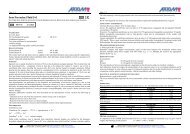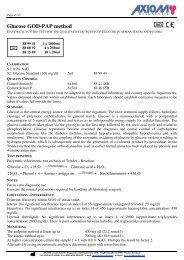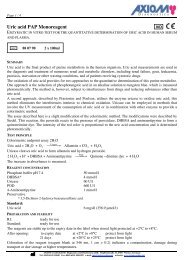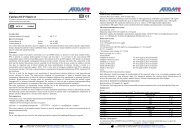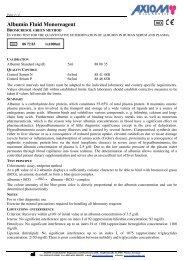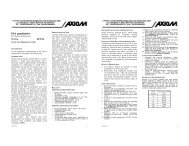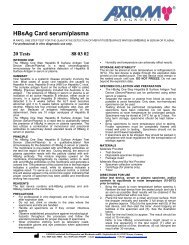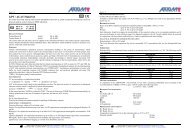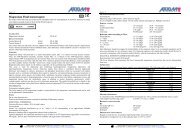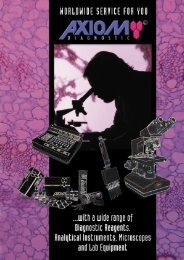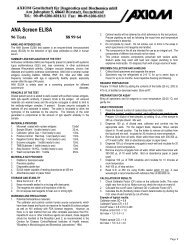Uric Acid PAP Fluid 5+1 - AXIOM Solutions
Uric Acid PAP Fluid 5+1 - AXIOM Solutions
Uric Acid PAP Fluid 5+1 - AXIOM Solutions
Create successful ePaper yourself
Turn your PDF publications into a flip-book with our unique Google optimized e-Paper software.
Page 2 / 4<br />
<strong>AXIOM</strong> Gesellschaft für Diagnostica und Biochemica mbH; Siegfriedstraße 14, 67547 Worms, Germany<br />
Tel.: 0049-6241-50040 Fax: 0049-6241-5004499 e-mail: info@axiom-online.net webseite: www.axiom-online.net<br />
D I A G N O S T I C<br />
MEASURING/REPORTABLE RANGE<br />
Unit conversion:<br />
mg/dl x 59.5 = µmol/l<br />
mg/dl x 0.059 = mmol/l<br />
Determine samples with uric acid concentrations > 25.0 mg/dl via the rerun function.<br />
On instruments without rerun function, dilute the samples manually with 0.9% NaCI or distilled/deionized water<br />
(e.g. 1 + 1). Multiply the result by the appropriate dilution factor (e.g. factor 2).<br />
EXPECTED VALUES<br />
Serum/plasma:<br />
Male:<br />
3.4 – 7.0 mg/dl (202.3 – 416.5 µmol/l)<br />
Female:<br />
2.4 – 5.7 mg/dl ( 142.8 – 339.2 µmol/l)<br />
Urine: (Reference range according to Krieg and Colombo)<br />
Morning urine 37 – 92 mg/dl (2200 – 5475 µmol/l)<br />
24 hour urine 200 – 1000 mg/24h (1200 – 5900 µmol/l/24h)<br />
corresponding to 13 – 67 mg/dl* (773 – 3986 µmol/l*)<br />
*Calculated from a urine volume of 1.5 l/24h<br />
Urine (Reference range according to Tietz)<br />
Average diet:<br />
250 – 750 mg/24h<br />
Low purine diet: Male: < 480 mg/24h<br />
Female: < 400 mg/24h<br />
High purine diet:<br />
< 1000 mg/24h<br />
Each laboratory should investigate the transferability of the expected values to its own patient population and if<br />
necessary determine its own reference range. For diagnostic purposes the uric acid results should always be<br />
assayed in conjunction with the patient's medical history, clinical examinations and other findings.<br />
ANALYTICAL SENSITIVITY (LOWER DETECTION LIMIT)<br />
Detection limit: 0.2 mg/dl (11.9 µmol/l)<br />
The lower detection limit represents the lowest measurable uric acid concentration that can be distinguished from<br />
zero.<br />
Imprecision<br />
Serum<br />
Reproducibility was determined using human samples and controls within run (n = 20). The following results<br />
were obtained:<br />
Within run<br />
Sample Mean mg/gl SD mg/dl CV %<br />
Sample 1 6.0 0.04 0.8<br />
Sample 2 4.23 0.03 0.7<br />
Sample 3 11.49 0.06 0.5<br />
Between day<br />
Sample Mean mg/gl SD mg/dl CV %<br />
Sample 1 7.21 0.12 1.7<br />
Sample 2 4.43 0.04 0.9<br />
Sample 3 11.03 0.13 1.2<br />
METHOD COMPARISON<br />
A comparison of the mti-diagnostics <strong>Uric</strong> <strong>Acid</strong> LS (y) with a commercial obtainable assay (x) gave with 44<br />
samples the following result: y = 1.008 x + 0.0645 r = 0.995<br />
REAGENT CONCENTRATION<br />
R1:<br />
Phosphate buffer pH 7.4<br />
DHBSA*<br />
Preservative<br />
* 3,5-Dichloro-2-hydroxy-benzenesulfonic acid<br />
50 mmol/l<br />
7 mmol/l



